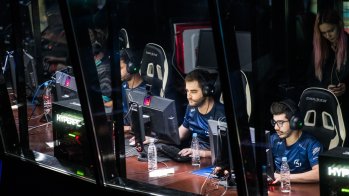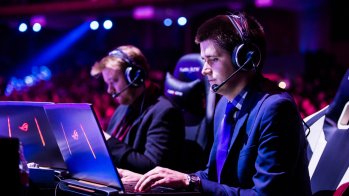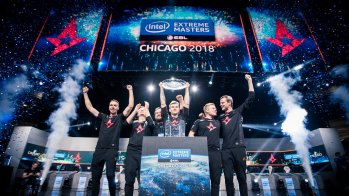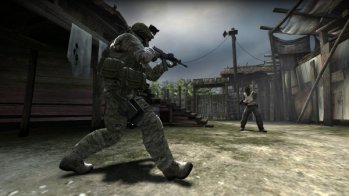
The early days of competitive computer games date back to 1952. At that time, computer scientist Alexander Shafto Douglas was working on his doctoral thesis on the interaction between humans and computers in Cambridge and came up with the idea of implementing the game "XOX" - better known to us as "Tic-Tac-Toe" or "Three Wins" - as a computer game. However, the human always played against the computer and could only determine who started.
The first actual multiplayer game was presented in 1958 by the then head of "Instrumentation Higinbotham" at the open day. It was called "Tennis for Two" and allowed two people to play against each other. The game was played with an early form of the joystick, which allowed players to hit the ball over the net and adjust its trajectory. Today, this title is considered by many to be the birth of eSports.
It would be a few years before the first eSports-like tournament would exist. The space game "Spacewar!" had already been written in 1962 on a PDP-10 computer by computer scientist Steve Russel and some colleagues like Martin Graetz and Wayne Wiitanen of the "Tech Model Railroad Club" at MIT. In it, two players play against each other with one spaceship each. Interestingly, the spaceships already had a limited supply of fuel and ammunition and had to fight against the gravitational field of a planet.
It is considered the world's first digital computer game and was named one of the ten most important computer games of all time by the New York Times in 2007. But on October 19, 1972, the time had finally come: the Artificial Intelligence Laboratory at Stanford University hosted the world's first eSports tournament, the "Intergalactic Spacewar Olympics." Twenty-four players met on this day to compete in "Spacewar! Incidentally, the winner at the time received a year's subscription to "Rolling Stones" magazine. The circle of people playing the early games was still limited to universities and similar institutions, since they had the technical facilities.

With the introduction of the "Magnavox Odyssey" in 1972, the first game console appeared that could be connected to a TV. Even though it was rather awkward to use - the playing field had to be glued to the TV in the form of a template in order to play - this console made digital gaming suitable for the masses.
In addition, arcades were subsequently established, which made it possible for the general public to play games on machines such as Pong. However, the competitive nature of the game only became possible with the introduction of permanent high score lists. One of the first machines to feature this option was "Sea Wolf" from 1976.
In 1979, two machines appeared, Asteroids and Starfire, which for the first time enabled gamers to immortalize themselves in a high score list with a personal name code. Since only a few machines offered the possibility to play against each other, these lists became a measure of the player's skill. With Space Invaders, Atari laid the foundation for the world's first major eSports tournament in 1978.
The early gaming classic was played at the 1980 Space Invaders Championships by over 10,000 gamers competing to win a version of Asteroids. On October 10, 1980, William Salvador Heineman was crowned the winner of the challenge. He was thus the first winner of a national video game competition.
Sport of the future: eSports in pictures
The next steps in the direction of eSports again came from the USA. The arcade operator Walter Day from Ottumwa in the state of Iowa founded the first referee service for video games on 09 February 1982 with the "Twin Galaxies National Scoreboard". The background was a story in Time magazine in 1982 about how 15-year-old Steve Juraszek set a record in Defender. Walter Day, however, knew a young player in his arcade who had beaten that record by far.
After consulting with machine manufacturer Williams and game developer Namco, he learned that there was no national leaderboard for Defender or any other video game - the initial spark for the creation of his service. Incidentally, the name Twin Galaxies is derived from the name of his own arcade. In addition to maintaining a national record list, "Twin Galaxies' Official Video Game & Pinball Book of World Records" was soon designed as a universal set of rules to prevent possible cheating by cheats or the like.
In 1983, he founded the U.S. National Video Team, the first professional gaming team in the world. He also organized the North American Video Game Challenge, the first video game masters tournament in the United States. Thanks to his extensive efforts around the topic of "video games", he can confidently be called one of the pioneers of eSports.
In Germany, Armin Stürmer founded the "Atari VCS Bundeliga" in 1982. A community project, which soon aroused the interest of Atari Germany due to the fast growing number of members. Here, various clubs competed against each other in four rounds and different games according to a fixed set of rules. The players were given a time limit of 15 or 30 minutes to score as many points as possible. The "German Champion" was determined at the end of the year. But already three years later Atari dropped out as an official partner and the Bundesliga was probably also discontinued in the same year.
eSports Boom: These Global Players Are Sponsors and Partners
In 1988, Netrek was released, the first multiplayer computer game that up to 16 players could play against each other over the Internet. It was a real-time strategy game in the Star Trek universe. The players take on the role of the Federation, the Klingons, the Romulans or the Orions and have to conquer a galaxy consisting of 40 planets. Netrek was played all over the world, but as in the early days of video games, it was mainly scientists, above all computer scientists, who fought hot battles, since it was mainly scientific institutions that had access to the early Internet.
At the beginning of the 1990s, Nintendo had also recognized the phenomenon of competition and organized the "Nintendo World Championships" in the USA in 1990. The winners of the competition, which was held in three age categories, received golden Nintendo gaming modules. The games were a triple-header of Super Mario Bros, Rad Racer and Tetris.
Blockbuster Video, a well-known video store chain in the USA, organized a world championship for video gamers in 1994 in cooperation with the American GamePro magazine. The tournament was held on the Super Nintendo and the Sega Mega Drive - games played included Sonic the Hedgehog 3 and Virtua Racing.
In the 1990s, it became clear that the future of competitive gaming would be found on PCs and in the network. As hardware became cheaper and more powerful, PCs became interesting for private households and thus also for the games industry. In the mid-90s, the first large LAN parties started, where gamers could compete with each other. But it wasn't just on a large scale that gaming via the network was becoming increasingly fascinating, especially on a smaller scale. More and more gamers met at small network sessions and played their favorite games.

From these meetings emerged the early clans that would drive professional play. For soon these teams competed against each other in the larger tournaments. With the advance of networking and the possibility of private Internet connections, the previous regional restrictions also fell away. Games such as Doom, Quake, Unreal Tournament or StarCraft are now an integral part of eSports history. They laid the foundation for playing against each other - whether in a team or alone.
As a result of this development, the first eSports leagues were founded towards the end of the 1990s: For example, the Electronic Sports League, which emerged from the "German Clan League" (DeCL), or the "ClanBase", which was launched in 1998.
The popularity of the topic in Germany was demonstrated in 1999 by the "Gamers' Gathering" in Duisburg. Here, more than 1600 players from all over Europe gathered to compete against each other in various games. In South Korea in particular, eSports was professionalized with the founding of the Korean e-Sports Association (KeSPA) in 2000, which from the very beginning focused on the possibilities of marketing eSports on TV.
And yet another highlight of 1999 favored network gaming against each other in teams: Counter-Strike. The game was released on June 19, 1999 and was the result of a small team of students. The gameplay revolves around the fight of an anti-terrorist unit against terrorists on a limited map. The game is played in rounds of five minutes each. The game spread rapidly and became a real multiplayer hit - and is still one of the most successful games in eSports history.
Thanks to developments in South Korea, the first "World Cyber Games" (WCG) were held here in Seoul in 2000. In 2003, the first Electronic Sports World Cup (ESWC) was played in Poitiers, France. The so-called "Grand Final" of this tournament was played in Paris in the summer. While the initial focus was on PC games, console titles were gradually included in the competition canon. Halo 2 is particularly worthy of mention here, which has played a pioneering role in console gaming since 2004.
Top 10: The most popular eSports games on Twitch
In 2005 , the"CPL World Tour" (Cyberathlete Professional League) was the first eSports event to be endowed with one million dollars. The game played was Painkiller, which was indexed in Germany at the time. The entire series was held in ten cities around the world and ended with a final in New York, which was broadcast live by the music channel MTV. The winner of the tour was the Dutchman "Sander "Vo0" Kaasjager", who earned a prize money of over 250,000 US dollars - while the winner of the final was the US American "Johnathan "Fatal1ty" Wendel".
And finally, the "Championship Gaming Series" (CGS for short) caused a sensation in 2007. The competition was held for the first time that year and offered prize money of over one million US dollars. Together with the associated player salaries of around five million US dollars, this resulted in the most expensive eSports tournament of all time.
In almost 70 years of computer gaming history, eSports has now established itself in many countries around the world. As a result, prize money has increased significantly, events are growing every year, and even eSports betting is offered. From a small niche, it has become a multi-media billion-dollar market that is now attracting many investors.
When did competitive computer games first emerge?
Competitive computer games emerged in the early 1950s, with "Tic-Tac-Toe" being one of the earliest examples.
What was the first multiplayer computer game?
The first multiplayer computer game was "Tennis for Two," introduced in 1958, allowing two players to compete against each other.
When was the world's first eSports tournament held?
The world's first eSports tournament, the "Intergalactic Spacewar Olympics," was held on October 19, 1972, at Stanford University.
When did gaming become suitable for the masses with the introduction of game consoles?
Gaming became suitable for the masses in 1972 with the introduction of the "Magnavox Odyssey," the first game console that could be connected to a TV.
When did high score lists become a measure of a player's skill?
In 1979, high score lists became a measure of a player's skill with games like Asteroids and Starfire.
Who founded the first referee service for video games?
Walter Day founded the first referee service for video games in 1982 with the "Twin Galaxies National Scoreboard."
What was the first multiplayer computer game to be played over the Internet?
"Netrek" was released in 1988 as the first multiplayer computer game that allowed up to 16 players to compete over the Internet.
When did gaming on PCs and in the network become popular?
Gaming on PCs and in the network became popular in the 1990s when hardware became cheaper and more powerful, leading to LAN parties and competitive play.

 Sports BusinessSki Mountaineering Goes Olympic: What Milano-Cortina 2026 Means
Sports BusinessSki Mountaineering Goes Olympic: What Milano-Cortina 2026 Means
- ISPO awards
- Mountain sports
- Bike
- Design
- Retail
- Fitness
- Health
- ISPO Job Market
- ISPO Munich
- ISPO Shanghai
- Running
- Brands
- Sustainability
- Olympia
- OutDoor
- Promotion
- Sports Business
- ISPO Textrends
- Triathlon
- Water sports
- Winter sports
- eSports
- SportsTech
- OutDoor by ISPO
- Heroes
- Transformation
- Sport Fashion
- Urban Culture
- Challenges of a CEO
- Trade fairs
- Sports
- Find the Balance
- Product reviews
- Newsletter Exclusive Area
- Magazine



























































